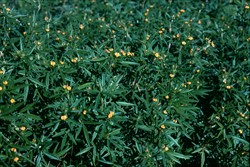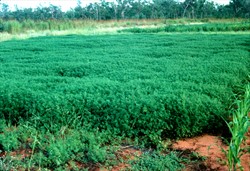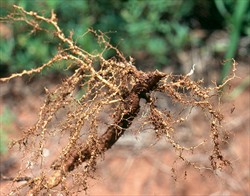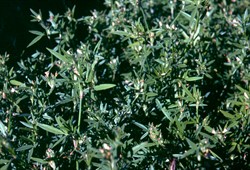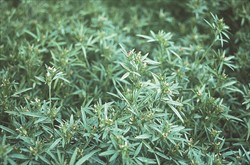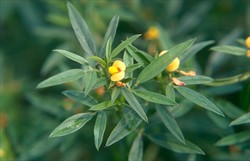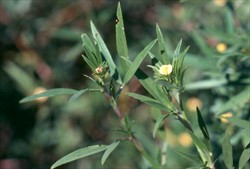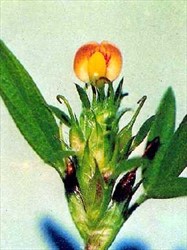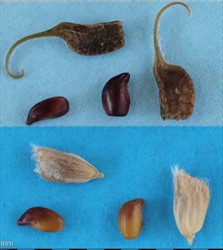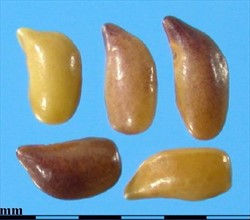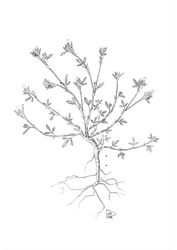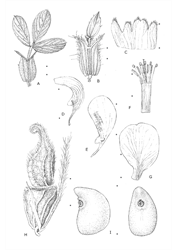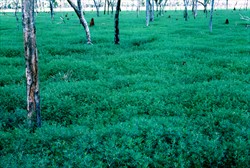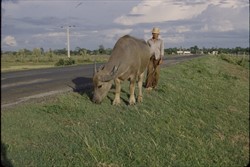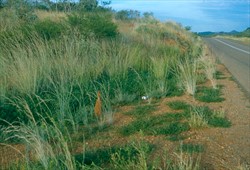Stylosanthes hamata
Tropical Forages
Stylosanthes hamata (L.) Taub.
Note: The taxonomy of this species has become confused in the literature because Stylosanthes hamata sensu stricto is diploid (2n = 20), but most forage references to S. hamata are to a group of allotetraploids (2n = 40) with Stylosanthes hamata (L.) Taub. and Stylosanthes humilis Kunth as the respective putative male and female genome donors. The tetraploid, which has different geographical distribution and different morphological and agronomic characteristics from the diploid, is yet to be described. While it has been suggested that it be referred to as Stylosanthes maracaibensis or S. hemihamata, these names have not been validly published according to the ICN (International Code of Nomenclature for algae, fungi, and plants), and could only be used if followed by "nomen nudum". The only forage cultivars released so far belong to the tetraploid group.
Basionym: Hedysarum hamatum L.
Note: This is a synonym for Stylosanthes hamata (L.) Taub. only. There is no synonym for the allotetraploid since there is no validly published name and description.
Family: Fabaceae (alt. Leguminosae) subfamily: Faboideae tribe: Dalbergieae subtribe: Stylosanthinae.
The allotetraploid species is a prostrate to semi-erect, herbaceous, annual or short-lived perennial to 75 cm tall. Stems much-branched with short white hairs down one side, alternating between internodes, glabrous elsewhere. Leaves trifoliolate; leaflets lanceolate, acute at base and acute to acuminate at apex, glabrous or sparsely hairy above and below, central vein prominent below with 4‒6 pairs of veins; central leaflet 16‒26 mm long, 3‒6 mm wide, petiole 3‒6 mm long; stipules bidentate, adnate to the base of the petiole with hairs on the sheath and teeth, sheath about 6 mm long. Inflorescence axillary or terminal, indeterminate, oblong spike 15‒25 mm long with 8‒14 flowers on a long rachis, terminal inflorescence with 2‒3 alternate spikes; outer bracts trifoliate, hairs on the margins, tapering to an acute or acuminate apex; outer bracteole and two inner bracteoles; axis rudiment 4‒5 mm long in first flower of the spike, 1‒2 mm in the next flower, minute or absent in upper flowers; corolla cream to yellow, the standard 4‒5 mm wide often with red splash at base. Loment mostly comprising two articulations, the lower pilose the upper glabrous, both usually fertile; beak slightly coiled, equal to or shorter than the upper articulation (total length of upper articulation + beak 6‒7 mm) with a few hairs on the under side adjoining the upper articulation. Seeds medium to dark brown or black, 2‒2.5 mm long, unsymmetrically reniform, radical ends fairly prominent. 270,000‒310,000 seeds-in-pod and 450,000‒520,000 dehulled seeds per kg.
Similar species
"tetraploid S. hamata" (2n = 40): short-lived perennial; bristles on stems absent; loment often with two fertile articles; only lower flowers subtended by axis rudiment; long terminal bristle on tips of stipules and bracts.
S. hamata s. str. (2n =2 0): perennial; bristles on stems absent; loment often with two fertile articles; each flower subtended by axis rudiment; terminal bristle on tips of stipules and bracts absent.
S. humilis (2n = 20): obligate annual; abundant bristles on stems, stipules and bracts; stipules forming a fused sheath around the stem; loment with only one fertile article; axis rudiment absent; longer beak than other two species.
Asia: 有钩柱花草 you gou zhu hua cao (China); kuthirai masal (India), हमाटा hamata (Marathi, India); thua-hamata (Thailand); cỏ stylo (Vietnam)
English: Caribbean stylo; pencil flower, mother segal/segel/sigil (West Indies); cheesytoes (USA); Lucy Julia (Cayman Islands); wild clover (Dutch Caribbean); donkey's milk, donkey weed, lady's fingers (Jamaica); Garfield bush, Sweet weed, wild clover (Eastern Caribbean)
French (Creole): petit trefle, ti twef, trefle jaune, twef jon (Eastern Caribbean)
Latin America: estilo hamata (Brazil); alfalfita maracaibera; zarzabacoa enana (Puerto Rico); verano (Spanish); tebeneque (Venezuela)
Note: Many of these names refer to the diploid Stylosanthes hamata sensu stricto.
Native:
Northern America: USA (southern Florida)
Caribbean: Anguilla; Antigua and Barbuda; Bahamas; Barbados; Cuba; Dominican Republic; Guadeloupe; Haiti; Jamaica; Martinique; Puerto Rico; St. Kitts and Nevis (St. Kitts); St. Lucia; St. Vincent and Grenadines (North Grenadines); Virgin Islands (British); Virgin Islands (U.S.) (mostly diploids)
Central America: Guatemala; Nicaragua (mostly diploids)
South America: Brazil (Maranhão, Mato Grosso do Sul); Colombia; Peru (Cajamarca); Venezuela (Aragua, Falcón, Federal District, Guárico, Lara, M´rrida, Miranda, Nueva Esparta, Sucre, Yaracuy, Zulia). Some of the Brazilian material is more strongly perennial (mostly tetraploids).
Cultivated/naturalized:
Northern America: USA (Florida)
Africa: West Africa
Asia: China; India; Thailand
Australasia: Australia (Northern Territory, Queensland, Western Australia)
Forage
Mostly used as legume component for permanent pastures. Suitable for cut-and-carry as green feed, or for hay if cut before dry season leaf fall when plants become increasingly stemmy. It is used for feeding cattle, goats, sheep, pigs and poultry. In NE Thailand successfully sown along hundreds of roadside kilometres for grazing by cattle and buffaloes during the wet-season (when there is no rice stubble available).
Environment
Growing use in silvipasture systems in India where it is used in undersowing Eucalytus and Dalbergia forests as well as a component in watershed and soil conservation programs. Can also be used as a ley in cropping systems with nitrogen benefits up to 90 kg/ha recorded in West Africa and northern Australia under experimental conditions.
Other
Used in folk medicines in Jamaica, being made into a tea to treat kidney pains,
Soil requirements
S. hamata s. str. (diploid) is not well adapted to acid soil conditions, originating from predominantly alkaline soils, from coarse coral beach sands to relatively heavy clays, where pH is not less than 6.2. The tetraploids from Venezuela that provide the common cultivars, grow on acid to alkaline soils (pH 5.4‒8.0, usually acid to slightly acid) of various textures, but not on heavy clays. They are tolerant of low P, but may respond to applied S. They extend the range originally set by S. humilis, which was largely restricted to infertile, acid, sandy surfaced soils, onto more alkaline soils. 'Verano' is more tolerant of moderate salinity levels than S. humilis.
Moisture
Annual rainfall in the regions where diploids are found ranges from 1,000 to 2,000 mm in Florida, USA from 980 to 1,500 mm in the Caribbean and from 350‒1,000 mm in northern South America. The tetraploids mainly occur in low to very low rainfall areas with a pronounced dry season. However, the cultivars, both of which originate from an area of c. 500 mm annual rainfall, are successfully planted in situations receiving 500‒2,000 mm with 700‒900 mm considered ideal. S. hamata is more drought tolerant than S. humilis. In areas with a very long dry season, S. hamata behaves as an annual. Some forms have quite good flood tolerance.
Temperature
Diploid races occur over most of the distribution between 3º S in Brazil and 28º N in Florida, but tetraploids are restricted to Colombia and Venezuela between 9º and 11.5º N. A distinct type of tetraploid occurs in southern Florida at about 26º N. Tetraploids are mainly found below 500 m asl in the tropics, and are less common than the diploids from 500 to 1,500 m asl. This equates to a range in average annual temperatures of about 23‒27 ºC. Aerial growth of the cultivars is cut even by light frosts, although the crowns can survive moderate frosts. They are best adapted to low elevation between the tropics where average annual temperatures are in excess of 22 ºC. Plant growth is limited when night temperatures decline to about 15 ºC, even with warmer day temperatures. In Queensland, Australia, the tetraploid cultivars are not well adapted beyond about 24 ºS (Gladstone).
Light
Not considered very shade tolerant - comparable with S. guianensis and Macroptilium atropurpureum.
Reproductive development
The diploids are primarily long day plants, while the tetraploids have an indeterminate flowering response to short days. The tetraploid cultivars normally flower 9‒10 weeks after germination, but perennating plants can flower within 6 weeks of the start of the season and continue throughout the growing season. Seed takes 15‒16 days to ripen from flowering.
Defoliation
Tolerates heavy grazing. Stocking rate should be adjusted to suppress associated grass if it appears too competitive, especially early in the growing season. Grazed S. hamata plants tend to perennate better than ungrazed plants. Higher yields can be obtained from commencing grazing at early flowering and then at 4-week intervals, over starting later and grazing less frequently. The stylo can become dominant at the expense of perennial grasses through heavy grazing. Grass and 'Verano' mixtures can be maintained by strategic fire and grazing management with appropriate phosphorus fertilizer use on less fertile acid tropical soils.
Fire
Tetraploid cultivars do not tolerate dry season fire, and plants fail to recover following fire. However, fire improves the germinability of hard seed in the soil, leading to recruitment of stand with the onset of the following wet season.
Guidelines for establishment and management of sown forages.
Establishment
Hard seed levels and embryo dormancy are high in fresh seed. Level of hard seed can be reduced by dry heat treatment of the seed, e.g. heated for 48 hours at 80 ºC, or heated for 15‒20 seconds at 155 ºC in a rotating drum, each followed by rapid cooling. High soil surface temperatures of the order of 50‒65 ºC have a similar effect on breakdown of hard seed. Seed can also be scarified using hot water treatment or dehulling. Use of more germinable seed leads to more rapid establishment and markedly higher early yields. Seed is best sown at the end of the dry season. Sowing rates of 1‒4 kg/ha of seed are used. The tetraploids are promiscuous in their rhizobial requirements, nodulating freely with a wide spectrum of native rhizobia. It may still be advantageous to inoculate with effective commercial strains such as CB 756 or CB 1650. The diploid types are highly specific and should be inoculated with CB 2126, a strain isolated from alkaline soils in their native environment.
Fertilizer
Can extract phosphorus from soils low in available soil P. Respond strongly to applied P. Application of 10‒20 kg/ha P at planting and every 2 or 3 years after establishment to maintain available soil P levels at ±8 ppm (mg/kg) improves both plant and animal performance. Molybdenum and sulphur may also be necessary in some situations.
Compatibility (with other species)
Combines well with low-growing species and competes well with weeds. Not suited to growing under trees because of limited shade tolerance.
Companion species
Grasses: Bothriochloa pertusa, Cenchrus ciliaris, Heteropogon contortus, Urochloa mosambicensis.
Legumes: Aeschynomene americana, Chamaecrista rotundifolia, Stylosanthes guianensis var. guianensis, S. scabra.
Pests and diseases
Tetraploid cultivars have good field tolerance of anthracnose disease caused by the fungal pathogens, Colletotrichum gloeosporioides and Colletotrichum dematium. Botrytis head blight, caused by Botrytis cinerea produces blighting of the inflorescence and apical dieback, and is particularly serious in seed crops during periods of high-rainfall. Web blight caused by Rhizoctonia solani can also be a problem in wet weather, damaging vegetative growth. There are no major insect pests.
Ability to spread
Seed is spread through ingestion and defecation by cattle, by water movement, and by stock movement, the hook on the upper pod segment adhering to the coat. Spread is favoured by rhizobial promiscuity, suggesting the tetraploids are more successful in this regard than the diploids away from their native habitat.
Weed potential
Not considered a serious weed. However, its ability to produce large amounts of seed and to colonize areas of low fertility obviously mean it has the potential to pose a weed threat in some areas.
Nutritive value
CP levels range from 17 to 24% in green leaf and 6‒12% in the stem, depending on age of regrowth and general growing conditions. IVDMD for whole tops are of the order of 60‒65%, comprising 66‒2% for green leaf and 33‒57% for stems. P levels of the forage depend on the soil P status and age of regrowth, from as low as 0.08‒0.3% (0.16‒0.37% of DM in green leaf and 0.06‒0.34% in stems). Nutritive value declines rapidly with the onset of dry season leaf drop.
Palatability/acceptability
Extremely palatable.
Toxicity
None recorded.
Feedipedia link
Dry matter
Under ideal conditions, can yield up to 17 t/ha DM in pure stands, but in mixed pasture, more commonly between 1 and 7 t/ha DM, depending on growing conditions, defoliation pressure and grass competition. Yield of between 7 and 10 t/ha per year have been recorded under a range of cutting frequencies, soils and rainfalls in cut-and-carry systems in Thailand. These yields are comparable to those of S. guianensis CIAT 184.
Animal production
Liveweight gain usually in the range of 140‒160 and up to 200 kg/hd/yr depending on stocking rates, growing conditions and mineral limitations. Annual gains can be reduced to 100 kg/hd on low fertility soils.
Like other Stylosanthes spp., S. hamata sensu lato is primarily a self-pollinating species, with low levels of outcrossing. Stylosanthes hamata (L.) Taub. sensu stricto is a diploid species (2n = 20). A form found in Colombia and Venezuela has been shown to be an allotetraploid (2n = 40) derived from diploid Stylosanthes hamata (L.) Taub. and S. humilis Kunth, and although often referred to in litlerature as tetraploid S. hamata, is strictly not Stylosanthes hamata (L.) Taub. It is, in effect, a different species and should be referred to using a different species epithet. Stylosanthes maracaibensis or hemihamata have been proposed, but have not been validly published. Accordingly, these would need to be followed by "nomen nudum", the Latin suffix meaning "naked name", alluding to the fact that the name refers to a new taxon published without a description or diagnosis or reference to a description or diagnosis. While "tetraploid S. hamata" from South America has a long beak on the terminal article of the loment similar to that on the diploid S. hamata and S. humilis, another allotetraploid from southern Florida has a short beak suggesting a different second progenitor.
Experience relates to the tetraploid Stylosanthes hemihamata nom. nud. Seed can be hand-picked or machine harvested by direct heading with or without suction harvest follow-up. Seed is normally machine-harvested once flowering has ceased or nearly so. Most seeds should be no longer green but brown. Although total seed set may be as high as 1,750‒2,000 kg/ha, harvest yields are usually of the order of 300‒600 kg/ha or 800 kg/ha from suction harvesting.
Like many Stylosanthes spp., the tetraploid Stylosanthes hemihamata nom. nud. are tolerant of a wide range of herbicides. For seed production, weeds can be reduced using pre-planting trifluralin and post-planting 2,4-D or 2,4-DB at low rates when plants are 5 cm high, higher rates on established crops. Also tolerant of bentazone, but susceptible to acifluorfen and fluazifop-butyl.
- Can be oversown into native pasture country or grown with sown grasses.
- Grows on low fertility soils.
- Highly persistent under grazing.
- Field tolerance of anthracnose disease.
- Intolerant of waterlogging.
- Frost sensitive.
- Restricted to tropical environments.
Register of Australian Herbage Plant Cultivars entries:
https://research.csiro.au/cultivars/wp-content/uploads/sites/162/2017/03/amiga.pdf
https://research.csiro.au/cultivars/wp-content/uploads/sites/162/2017/03/verano.pdf
Edye, L.A. and Maass, B.L. (1997) Recent advances in studies of anthracnose of Stylosanthes. I. The biogeography of Stylosanthes hamata, S. scabra and "Stylosanthes seabrana". Tropical Grasslands 31:417–423. bit.ly/2mqiT4n
Edye, L.A. and Topark-Ngarm, A. (1992) Stylosanthes hamata (L.) Taub. In: Mannetje, L.’t and Jones, R.M. (eds) Plant Resources of South-East Asia No. 4. Forages. Pudoc Scientific Publishers, Wageningen, the Netherlands. p. 213–216. edepot.wur.nl/327785
Hall, T.J. and Glatzle, A. (2004) Cattle production from Stylosanthes pastures. In: Chakraborty, S. (ed) High-yielding anthracnose-resistant Stylosanthes for agricultural systems. ACIAR Monograph No. 111. Australian Centre for International Agricultural Research (ACIAR), Canberra, Australia. p. 51–64. aciar.gov.au/node/8471
Maass, B.L. and Sawkins, M. (2004) History, relationships and diversity among Stylosanthes species of commercial significance. In: Chakraborty, S. (ed) High-yielding anthracnose-resistant Stylosanthes for agricultural systems. ACIAR Monograph No. 111. Australian Centre for International Agricultural Research (ACIAR), Canberra, Australia. p. 9–26. aciar.gov.au/node/8471
Pengelly, B.C., Clem, R.L. and Whitbread, A.M. (2004) The role of Stylosanthes spp. in mixed crop-livestock systems in Africa and Australia. In: Chakraborty, S. (ed) High-yielding anthracnose-resistant Stylosanthes for agricultural systems. ACIAR Monograph No. 111. Australian Centre for International Agricultural Research (ACIAR), Canberra, Australia. p. 77–84. aciar.gov.au/node/8471
Phaikaew, C., Ramesh, C.R., Kexian, Yi and Stür, W. (2004) Utilisation of Stylosanthes as a forage in Asia. In: Chakraborty, S. (ed) High-yielding anthracnose-resistant Stylosanthes for agricultural systems. ACIAR Monograph No. 111. Australian Centre for International Agricultural Research (ACIAR), Canberra, Australia. p. 65–76. aciar.gov.au/node/8471
Sonoda R.M. and Brolmann J.B. (1980) Differences in susceptibility of Stylosanthes hamata to Colletotrichum gloeosporioides. Plant Disease 64:553–554. bit.ly/2JvjqKw
Stace, H.M. and Edye, L.A. (eds) (1984) The biology and agronomy of Stylosanthes. Academic Press, Sydney, Australia. doi.org/10.1016/B978-0-12-661680-4.X5001-X
Vithanage, V. and Chakraborty, S. (1992) Identification of selected cultivars and accessions of Stylosanthes by isozyme analysis. Tropical Grasslands 26:156–164. bit.ly/39v1V7r
'Amiga' (CPI 55822) Released in Australia (1988). Origin 12 km N of Maracaibo, Venezuela (10⁰ 48' N, 30 m asl, rainfall 460 mm). Morphologically similar to 'Verano'. Selected for seed production (up to 50% greater than 'Verano') and DM yield, and resistance to anthracnose. Extends S. hamata range into drier and cooler environments (rainfall >500 mm, <23 °S) but both cultivars are poorly adapted to subtropical environments. Similar to 'Verano' in flowering time, nodulation response, palatability, digestibility and nutritive value, but greater longevity of individual plants.
'Verano' (CPI 38842) Released in Australia (1973). Origin 8 km SW of Maracaibo, Venezuela (10⁰ 36' N, 10 m asl, rainfall 530 mm). Selected as more productive, less disease-prone alternative to S. humilis in the dry tropics of northern Australia.
Note: 'Amiga' differs from 'Verano' in having the following combination of characters: leaflets and unifoliolate floral bracts are acuminate, a greater percentage of double-articled loments, outer floral bracts broad with acuminate apex (apex acute in 'Verano'). The 2 cultivars also have different electrophoretic phenotypes for the enzyme acid phosphatase. 'Amiga' is homozygous (FF) for the fast-migrating band whereas 'Verano' has a null phenotype (no band present).
CPI 55804, CPI 55811 A, CPI 55871 Origin Brazil. More strongly perennial than other germplasm, including 'Verano' and 'Amiga' but have lower productivity.
CPI 61670 Selected in Timor, Indonesia. Higher yields than 'Amiga' and 'Verano' on alkaline clay soil with pH 8.6 and average annual rainfall of 1,200 mm. Lower DM yield and seed yield than S. seabrana.
ILRI 15876 (CPI 110073, CIAT 12538), ILRI 15868 (CPI 110063, CIAT 11769) Selected at Kaduna in the subhumid zone of Nigeria. Comparable, or superior, to 'Verano', higher biomass yields and remaining greener in the dry season.
CPI 110094, CPI 110159, CPI 110185 Selected in Australia. Origin Venezuela. Very high yielding (up to 17.4 t/ha/yr DM). Anthracnose in some lines.
